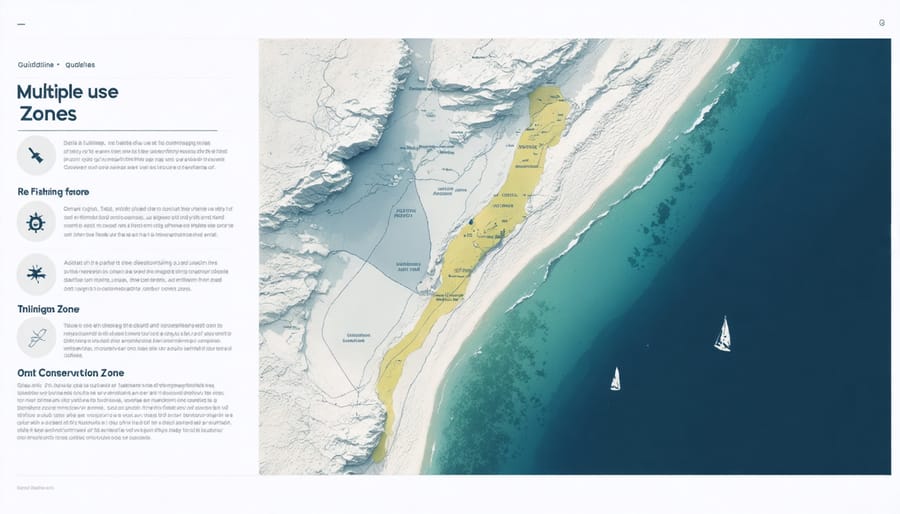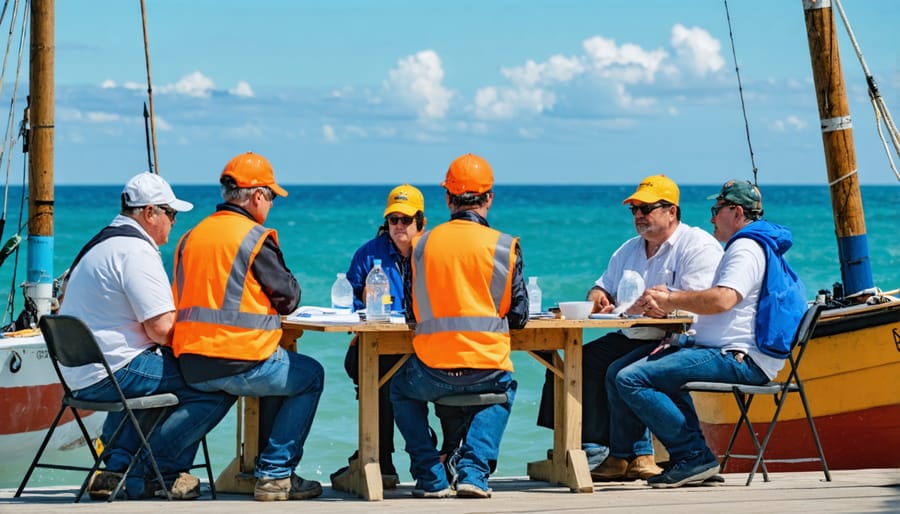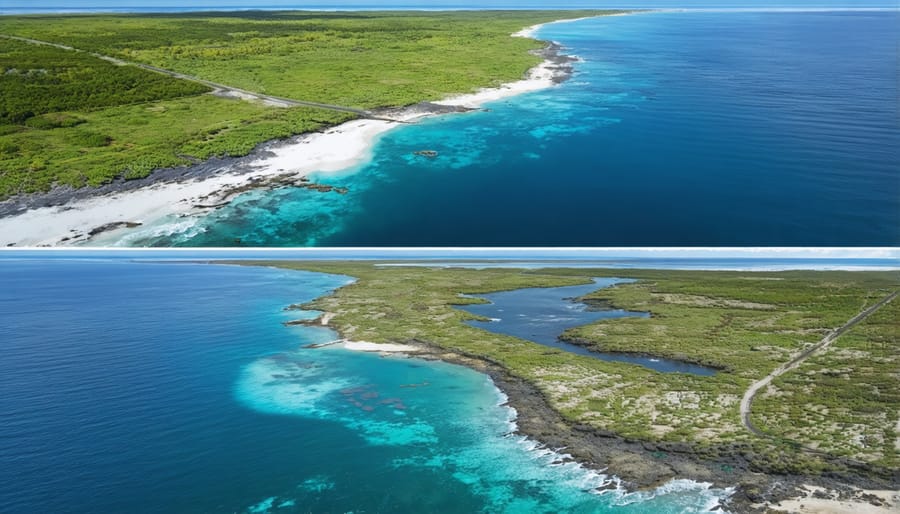
Coastal zones stand as some of Earth’s most dynamic and valuable ecosystems, yet they face unprecedented challenges from climate change, population growth, and competing economic interests. Integrated Coastal Management (ICM) emerges as a revolutionary approach that transforms how we protect and sustainably develop these critical areas. By harmonizing environmental conservation with social and economic needs, ICM creates a framework where coastal communities can thrive while preserving their natural heritage for future generations.
Unlike traditional single-sector approaches, ICM coordinates the efforts of multiple stakeholders – from local fishermen to government agencies – in a comprehensive strategy that addresses the interconnected challenges of coastal management. This holistic method recognizes that coastal ecosystems don’t exist in isolation but are part of a complex web of environmental, social, and economic relationships that require careful balance and continuous adaptation.
As coastal regions worldwide grapple with rising seas, extreme weather events, and increasing development pressures, ICM offers a proven pathway to build resilient communities while safeguarding marine ecosystems. Through collaborative decision-making and science-based planning, this approach ensures that coastal development serves both human needs and environmental sustainability, creating a blueprint for coastal stewardship that benefits all.
The Core Principles of Integrated Coastal Management
Ecosystem-Based Approach
The ecosystem-based approach represents a fundamental shift in coastal management philosophy, recognizing that coastal areas function as interconnected systems rather than isolated components. This holistic perspective considers how various elements – from coral reefs and mangrove forests to human communities and economic activities – interact and influence each other within the coastal environment.
Unlike traditional management approaches that might focus solely on specific issues like fishing quotas or water quality, ecosystem-based ICM examines the entire web of relationships that sustain coastal health. This comprehensive approach is crucial for effective marine biodiversity conservation and the maintenance of ecosystem services that coastal communities depend upon.
For example, when managing a mangrove forest, this approach considers not just the trees themselves, but also their role in preventing coastal erosion, serving as nurseries for fish species, filtering pollutants, and protecting communities from storm surges. It also accounts for human activities, climate change impacts, and the economic value these ecosystems provide to local communities.
This integrated perspective helps managers identify and address root causes of environmental degradation rather than just treating symptoms, leading to more effective and sustainable solutions for coastal challenges.

Stakeholder Engagement
Stakeholder engagement forms the cornerstone of successful integrated coastal management, bringing together diverse groups with varying interests in coastal areas. These stakeholders include local communities, fishermen, tourism operators, industrial users, environmental organizations, government agencies, and indigenous peoples.
Effective coastal management requires the active participation of all these groups in decision-making processes, from initial planning to implementation and monitoring. This collaborative approach ensures that management strategies reflect the needs and concerns of all affected parties while promoting sustainable resource use and environmental protection.
Regular stakeholder meetings, workshops, and public consultations provide platforms for sharing knowledge, addressing conflicts, and building consensus. Local fishermen, for instance, bring generations of traditional knowledge about marine ecosystems, while scientists contribute research-based insights. This knowledge exchange strengthens management decisions and increases community buy-in.
The engagement process also helps build trust between different groups and fosters a sense of shared responsibility for coastal resources. When stakeholders feel their voices are heard and their interests considered, they’re more likely to support and comply with management measures. This participatory approach has proven particularly successful in establishing marine protected areas and developing sustainable fishing practices.

Building Societal Resilience Through ICM
Economic Benefits
Integrated Coastal Management (ICM) creates significant economic advantages for coastal communities while maintaining environmental sustainability. By coordinating various coastal activities, ICM helps optimize resource use and reduces conflicts between different sectors such as fishing, tourism, and shipping.
Tourism benefits substantially from ICM practices, as preserved beaches, clean waters, and thriving marine ecosystems attract visitors and generate revenue. For example, well-managed coral reefs can generate up to $1.25 million per square kilometer annually through sustainable tourism activities.
The fishing industry sees improved long-term yields through ICM’s sustainable fishing practices and habitat protection measures. When fishing grounds are properly managed, local communities can maintain steady income streams while ensuring fish populations remain viable for future generations.
ICM also reduces economic losses from natural disasters by protecting natural barriers like mangroves and wetlands. These ecosystems can reduce flood damage by up to 66%, saving coastal communities millions in disaster recovery costs. Additionally, healthy coastal ecosystems provide natural infrastructure that often proves more cost-effective than engineered solutions.
Port operations benefit from ICM through improved coordination and reduced environmental impacts. This coordination leads to more efficient shipping routes, reduced dredging needs, and better waste management practices, all of which contribute to cost savings and increased operational efficiency.
The creation of marine protected areas within ICM frameworks has shown to increase fish populations in adjacent waters, benefiting both commercial fishing operations and local economies through spillover effects.
Social Adaptability
Communities along coastlines must continually adapt to environmental changes, from rising sea levels to increased storm frequency. Successful integrated coastal management relies heavily on building social resilience and preparing communities for these challenges. Local knowledge and traditional practices often provide valuable insights into sustainable coastal management, and incorporating these perspectives strengthens community buy-in and project effectiveness.
Coastal communities are increasingly implementing adaptive management strategies, such as establishing early warning systems for extreme weather events and developing evacuation plans. Educational programs play a crucial role in raising awareness about climate change impacts and encouraging sustainable practices. These initiatives help residents understand their role in coastal protection and conservation.
Social networks and community organizations serve as essential platforms for information sharing and collective action. Regular community meetings, workshops, and participatory planning sessions enable stakeholders to voice concerns and contribute to decision-making processes. This inclusive approach ensures that management strategies reflect local needs and capabilities.
Many coastal areas have established community-led monitoring programs, where residents participate in data collection and environmental surveillance. These citizen science initiatives not only provide valuable data but also foster a sense of environmental stewardship among community members. Success stories from various coastal regions demonstrate how well-prepared communities can effectively respond to environmental challenges while maintaining their cultural and economic activities.
Implementation Strategies
Policy Framework Development
The development of effective coastal management policies requires a carefully structured framework that balances environmental protection with socio-economic needs. This process typically begins with a comprehensive assessment of the coastal area, including environmental conditions, resource usage patterns, and stakeholder interests.
A successful policy framework incorporates multiple layers of governance, from local to national levels, ensuring coordination and avoiding conflicting regulations. Key elements include clear objectives, measurable targets, and specific timelines for implementation. These policies must address both immediate concerns and long-term sustainability goals while remaining flexible enough to adapt to changing conditions.
Stakeholder engagement plays a crucial role in policy development. Local communities, indigenous groups, industry representatives, and environmental organizations should all have opportunities to contribute their perspectives and knowledge. This inclusive approach helps ensure policies are practical, equitable, and more likely to gain public support.
The framework should also establish mechanisms for monitoring and evaluation, allowing for policy adjustments based on outcomes. Regular reviews help identify successful strategies and areas needing improvement. Additionally, policies must incorporate provisions for enforcement, including clear guidelines for compliance and consequences for violations.
Successful frameworks often include funding mechanisms, capacity-building programs, and provisions for scientific research to support evidence-based decision-making.
Monitoring and Assessment
Effective monitoring and assessment are crucial components of integrated coastal management, ensuring that implemented strategies achieve their intended goals. This process involves regular data collection through various methods, including satellite imagery, water quality testing, and species population surveys. Modern technologies, including DNA science in marine conservation, have revolutionized our ability to track ecosystem health and biodiversity changes.
Successful ICM programs establish clear indicators and benchmarks to measure progress. These typically include environmental metrics (such as water quality and habitat coverage), socioeconomic factors (like community well-being and sustainable resource use), and governance effectiveness (including policy compliance and stakeholder engagement).
Regular assessment cycles, usually conducted annually or bi-annually, help identify both achievements and areas needing improvement. This adaptive management approach allows for timely adjustments to strategies and actions based on monitoring results. Community participation in monitoring efforts, through citizen science programs and local knowledge integration, has proven invaluable in many regions.
The assessment process should be transparent, with results communicated to all stakeholders through accessible reports and community meetings. This transparency helps maintain trust and support for ICM initiatives while ensuring accountability in coastal management efforts.
Success Stories in Action
Several coastal regions worldwide demonstrate the remarkable success of integrated coastal management (ICM) approaches. In the Philippines, the Tubbataha Reefs Natural Park showcases how collaborative management between local communities, government agencies, and NGOs can lead to extraordinary conservation outcomes. Since implementing ICM practices in 1988, fish biomass has increased by 200%, and coral cover has maintained excellent condition despite global climate challenges.
Another inspiring example comes from Australia’s Great Barrier Reef Marine Park, where ICM strategies have created a balanced approach between tourism, fishing, and conservation. The park’s zoning plan, developed through extensive stakeholder consultation, has become a global model for marine spatial planning. Modern techniques, including genetic monitoring of marine ecosystems, have helped track the effectiveness of these management strategies.
The Chesapeake Bay Program in the United States demonstrates how ICM can reverse environmental degradation. Through coordinated efforts across six states, the program has achieved significant improvements in water quality, with underwater grass beds expanding from 38,000 acres in 1984 to over 100,000 acres today. Local communities have seen the return of iconic species like blue crabs and striped bass.
In Europe, the Netherlands’ “Building with Nature” initiative showcases innovative ICM approaches. Instead of traditional hard engineering solutions, they’ve implemented nature-based coastal defense systems, including artificial sand dunes and oyster reefs. These solutions not only protect against sea-level rise but also enhance biodiversity and create recreational opportunities for local communities.
These success stories share common elements: strong stakeholder engagement, science-based decision-making, adaptive management approaches, and clear monitoring and evaluation systems. They prove that when communities, governments, and scientists work together, ICM can create resilient coastal ecosystems while supporting sustainable economic development.

Future Challenges and Opportunities
As coastal regions face increasing pressures from climate change, population growth, and economic development, Integrated Coastal Management (ICM) must evolve to address new challenges. Rising sea levels and more frequent extreme weather events pose significant threats to coastal communities and ecosystems. Additionally, emerging technologies like genomic research are providing new opportunities for understanding and protecting marine biodiversity.
The digital revolution presents both challenges and opportunities for ICM. While data collection and monitoring capabilities have improved dramatically through satellite technology and AI-driven analysis, many coastal regions still lack the infrastructure and expertise to implement these tools effectively. Capacity building and knowledge transfer between developed and developing nations will be crucial in addressing this gap.
Looking ahead, successful ICM will require greater integration of traditional ecological knowledge with modern scientific approaches. Communities that have lived along coastlines for generations often possess valuable insights that can complement contemporary management strategies. The challenge lies in creating frameworks that respect and incorporate these diverse knowledge systems while maintaining scientific rigor.
The future of ICM also depends on developing more adaptive management approaches that can respond quickly to changing conditions. This includes implementing flexible policies that can be adjusted based on monitoring results and emerging threats, as well as fostering stronger international cooperation to address transboundary issues affecting coastal zones.
Integrated Coastal Management represents a vital framework for protecting and sustaining our coastal environments while supporting the communities that depend on them. Throughout this exploration, we’ve seen how ICM brings together diverse stakeholders, from local communities to government agencies, in a coordinated effort to address complex coastal challenges.
The success of ICM lies in its holistic approach, combining scientific understanding with practical management strategies. By considering environmental, social, and economic factors simultaneously, ICM provides a comprehensive solution to coastal zone management that benefits both nature and people.
As coastal regions face increasing pressures from climate change, population growth, and economic development, the importance of ICM cannot be overstated. The examples we’ve examined demonstrate how effective implementation can lead to improved ecosystem health, sustainable resource use, and more resilient coastal communities.
You can support ICM initiatives in various ways: engage with local coastal management programs, participate in beach clean-ups, support marine conservation organizations, or share knowledge about sustainable coastal practices within your community. For professionals, consider joining ICM networks or contributing expertise to ongoing projects.
The future of our coastal zones depends on collective action and commitment to integrated management approaches. By working together and supporting ICM principles, we can ensure that future generations inherit healthier, more sustainable coastal environments while maintaining the economic and social benefits these vital areas provide.
jessica
Ava Singh is an environmental writer and marine sustainability advocate with a deep commitment to protecting the world's oceans and coastal communities. With a background in environmental policy and a passion for storytelling, Ava brings complex topics to life through clear, engaging content that educates and empowers readers. At the Marine Biodiversity & Sustainability Learning Center, Ava focuses on sharing impactful stories about community engagement, policy innovations, and conservation strategies. Her writing bridges the gap between science and the public, encouraging people to take part in preserving marine biodiversity. When she’s not writing, Ava collaborates with local initiatives to promote eco-conscious living and sustainable development, ensuring her work makes a difference both on the page and in the real world.
